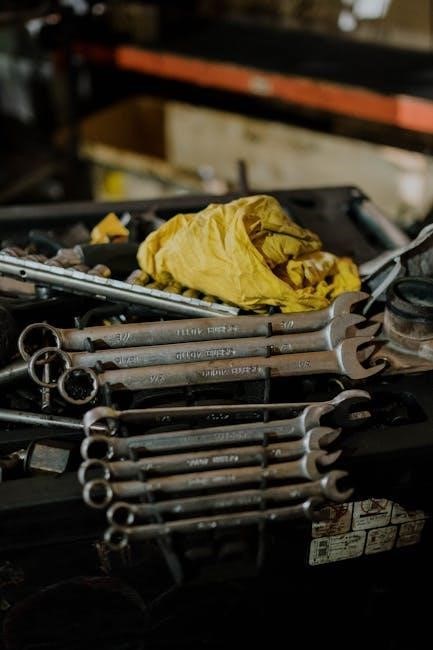This comprehensive guide provides detailed instructions for troubleshooting, maintaining, and repairing GE clothes washers. It covers essential safety protocols, common issues, and DIY repair solutions for homeowners.
Overview of GE Washing Machines
GE washing machines are known for their durability and innovative features, offering both top-load and front-load models. They provide efficient cleaning with advanced settings like multiple wash cycles and energy-saving options. The GE Profile series stands out for its quiet operation and smart technology integration. These machines are designed to handle various fabric types and stains effectively. Regular maintenance and proper repair ensure optimal performance. GE also offers comprehensive service manuals and repair guides for easy troubleshooting and DIY fixes.
Importance of Proper Maintenance and Repair
Regular maintenance extends the lifespan of GE washers, preventing costly repairs. Cleaning the interior, checking hoses, and ensuring proper installation are crucial. Neglecting maintenance can lead to issues like mold growth or malfunctioning parts. Timely repairs prevent minor problems from escalating, ensuring energy efficiency and optimal performance. Referencing GE’s official manuals ensures accurate troubleshooting and safe repairs. Proper care enhances reliability, saving time and money while maintaining hygiene and efficiency in daily use.

Safety Precautions for GE Washer Repair
Always unplug the washer before starting repairs. Wear safety glasses and gloves to protect against sharp parts and electrical hazards. Follow GE’s guidelines strictly.
General Safety Guidelines
Always unplug the washer from the power source before starting any repair to avoid electric shock. Wear safety gloves and protective eyewear when handling sharp or heavy parts. Ensure the washer is stable and on a level surface to prevent accidents. Follow the instructions in the GE repair manual carefully, and never attempt repairs without proper knowledge. Keep children and pets away from the work area for their safety.
Be aware of moving parts and hot surfaces during disassembly. Never bypass safety features or ignore warnings in the manual. If unsure about a procedure, consult a professional technician to ensure your safety and the appliance’s proper functioning.
Personal Protective Equipment Requirements
When performing repairs, wear safety glasses with side shields to protect your eyes from debris. Steel-toe shoes are essential to prevent foot injuries from heavy parts. Use safety gloves to avoid cuts and abrasions while handling sharp components. A dust mask is recommended when working with dusty or chemical-based materials. Ensure all protective gear fits properly and is in good condition to maintain effectiveness. These precautions align with GE’s recommendations for safe appliance servicing.
Troubleshooting Common Issues
Identify error codes and symptoms to diagnose problems like failure to start, poor drainage, or excessive noise. Check power supply, detergent usage, and drain filters for quick fixes.
Identifying Error Codes and Symptoms
GE washers often display error codes like “E1” or “E2,” indicating issues such as sensor malfunctions or drainage problems. Symptoms may include the washer not starting, excessive noise, or poor cleaning performance. Check the user manual or service guide for specific code meanings, as models like GTW750CPLDG have unique diagnostics. Inspect for visible damage, loose connections, or blockages in the drain pump. Addressing these early prevents further damage and ensures efficient repair outcomes.
Basic Diagnostic Steps for GE Washers
Begin by checking the power supply and ensuring the washer is properly plugged in. Verify error codes on the display, such as “E1” or “E2,” and refer to the manual for interpretations. Inspect the drain pump filter for blockages and ensure the washer is level. Run a diagnostic cycle if available. Check for loose connections or worn parts. If issues persist, consult the service manual or contact a professional for advanced troubleshooting. Regular diagnostics help maintain efficiency and prevent major repairs.
Regular Maintenance Tips
Regular maintenance ensures optimal performance and longevity of GE washers. Clean the interior, check for worn parts, and ensure proper installation to prevent issues and maintain efficiency.
Cleaning the Washer Interior
Cleaning the interior of your GE washer is essential for maintaining hygiene and performance. Run a cleaning cycle with a washer cleaner or vinegar to remove detergent residue and odors; Always follow the instructions in your GE manual for specific cleaning recommendations. Regular cleaning helps prevent mold buildup and ensures fresh-smelling laundry every time. Make it a routine practice to keep your washer in top condition.
Checking and Replacing Worn Parts
Regularly inspecting the washer’s components can prevent major breakdowns. Check the tub seal, drain pump, and belts for wear. Replace any damaged parts promptly using genuine GE replacements. Refer to your repair manual for specific instructions and diagrams. Early detection of worn parts ensures optimal performance and extends the lifespan of your appliance. Always follow safety guidelines when handling repairs to avoid injuries or further damage.
GE Washer Disassembly and Reassembly
Disconnect power, remove the top, and take out the tub. Handle the control panel and internal components with care. Wear safety gloves and goggles.
Step-by-Step Disassembly Process
Start by disconnecting power and water supplies. Remove the top panel by taking out screws at the back. Gently lift the lid and set aside. Next, detach the control panel and drain pump. Use a wrench to loosen tub mounting nuts. Carefully lift the tub and set it on a sturdy surface. Remove internal components like the agitator and bearings. Document each step for easy reassembly. Always consult the official GE manual for specific model instructions.
Reassembling the Washer Correctly
Begin by reattaching the tub securely to the base, ensuring all suspension springs are evenly tightened for balance. Reinstall the drain pump, connecting hoses with plumber’s tape and securing clips to prevent leaks. Attach the control panel, carefully reconnecting wires to the correct terminals using the wiring diagram. Replace the top panel, aligning and screwing it into place firmly. Reinstall the agitator, ensuring it’s securely fastened. Check all internal components like bearings and seals for proper placement. Test the washer with a short cycle to ensure functionality and inspect for leaks or unusual noises. Verify the washer is balanced by adjusting the legs for stability. Double-check all bolts and connections for tightness to prevent future issues.

Repair Guides for Specific GE Models
Guides offer model-specific repair instructions for GE top load and front load washers, including GTW750CPLDG and GTW750CSLWS, covering tub seal and drain pump replacements effectively.
GE Top Load Washer Repair
GE top load washers require specific attention to their unique mechanisms. Common repairs include replacing the tub seal, fixing the drain pump, and addressing issues with the control panel. Regular maintenance, such as cleaning the interior and checking for worn parts, can prevent major breakdowns. Always refer to the official service manual for model-specific instructions, like GTW750CPLDG and GTW750CSLWS, to ensure accurate repairs and safety. DIY solutions can save costs but require careful adherence to guidelines to avoid further damage or safety risks.
GE Front Load Washer Repair
GE front load washers are known for their energy efficiency and advanced features. Common repairs include addressing mold buildup, fixing leakages, and resolving issues with the door gasket. Regular cleaning of the gasket and drain pump is essential to maintain performance. Refer to the official service manual for specific models, such as the GE Front Load Washer with Energy Star qualification, to ensure accurate repairs. Proper maintenance can extend the appliance’s lifespan and prevent costly breakdowns, while DIY fixes require careful adherence to safety guidelines and model-specific instructions.

Accessing GE Repair Manuals and Resources
Download official GE repair manuals and guides from GE Appliances’ website or platforms like Repair Clinic and Sears Parts Direct for model-specific instructions and troubleshooting support.
Downloading Official GE Manuals
Official GE repair manuals are available for download on the GE Appliances website. Enter your washer’s model number to access specific guides. Platforms like Repair Clinic and Sears Parts Direct also offer downloadable manuals. These resources provide detailed instructions for troubleshooting, maintenance, and repairs. Ensure you download the correct manual for your model to avoid confusion. PDF and booklet formats are commonly available, offering comprehensive support for DIY repairs and professional servicing.
Online Platforms for Repair Information
Platforms like Repair Clinic and Sears Parts Direct offer extensive repair resources for GE washers. These sites provide downloadable manuals, part diagrams, and troubleshooting guides. Additionally, the official GE Appliances website allows users to search by model number for specific repair information. Online forums and DIY repair communities also share valuable insights and solutions. These platforms are essential for accessing detailed instructions and diagnostic tools, ensuring effective repairs and maintenance for your GE clothes washer.

Advanced Diagnostic Techniques
Advanced diagnostic techniques for GE clothes washers include using diagnostic modes and interpreting error codes to efficiently identify issues, ensuring accurate and effective repairs.
Using Diagnostic Modes
GE clothes washers feature advanced diagnostic modes to identify issues efficiently. By pressing specific buttons, users can activate these modes, which display error codes or blink patterns. This helps pinpoint malfunctions, such as faulty sensors or motor issues. Diagnostic modes provide detailed insights, guiding repairs and minimizing guesswork. Always consult the manual for model-specific instructions to ensure accurate troubleshooting and safe appliance operation.
Interpreting Error Codes
GE clothes washers display error codes to indicate specific issues, such as “E1” for water level sensor malfunctions. Refer to the user manual or service guide to decode these codes accurately. Each code corresponds to a particular problem, like faulty sensors or drain pump issues. Proper interpretation is crucial for effective troubleshooting and repair. Always follow the recommended steps to address the issue, ensuring safety and preventing further damage to the appliance. This helps in resolving problems efficiently and extending the washer’s lifespan.
Common GE Washer Repairs
Common repairs include replacing tub seals, fixing drain pumps, and addressing sensor malfunctions. These issues often arise from wear and tear or improper maintenance practices over time.
Replacing the Tub Seal
The tub seal replacement is a common repair for GE washers, often needed due to leaks or mold buildup. Ensure the washer is unplugged before starting. Remove the tub cover and inspect the seal for damage. Use a new seal, apply adhesive if required, and align it properly. Replace the cover and test the washer to ensure leaks are resolved. This repair prevents water damage and maintains efficiency.
Fixing the Drain Pump
Fixing the drain pump on a GE washer involves inspecting for blockages or damage. Unplug the washer and access the pump, typically located at the bottom or back. Clean debris from the filter and impeller. If damaged, replace the pump with a compatible part. Reassemble carefully and test the washer to ensure proper drainage. Regular maintenance helps prevent clogs and extends the washer’s lifespan. Always follow safety guidelines when performing repairs.
Mastering GE washer repair empowers you to resolve common issues effectively. With proper tools and knowledge, you can extend your appliance’s lifespan and performance confidently.
Final Tips for Successful Repair
- Distribute laundry evenly to ensure balanced washing and prevent damage.
- Regularly clean the washer interior to maintain hygiene and efficiency.
- Always refer to the official GE manual for model-specific instructions.
- Use genuine GE parts for replacements to ensure compatibility and longevity.
- Test the washer after repairs to confirm proper functionality.
By following these tips, you can ensure safe, effective, and long-lasting repairs for your GE washer.
When to Call a Professional
If you encounter complex issues like error codes or major component failures, it’s best to contact a certified GE technician. They have the expertise and tools to handle advanced diagnostics and repairs safely. Additionally, if you’re unsure about a procedure or lack experience with appliance repair, seeking professional help prevents further damage and ensures compliance with safety standards. Always prioritize your safety and the longevity of your washer by consulting a professional when needed.